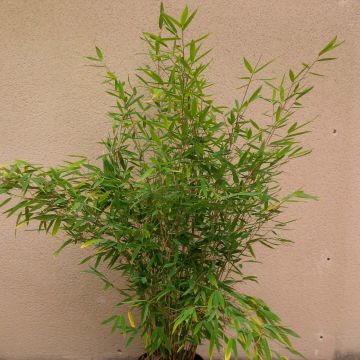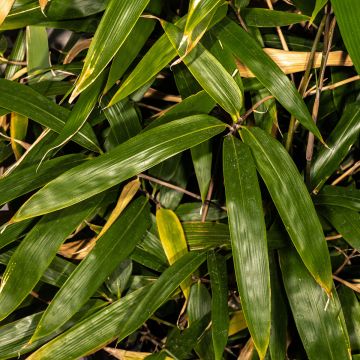

Shibataea kumasaca - Dwarf Bamboo


Shibataea kumasaca - Dwarf Bamboo
Shibataea kumasaca - Dwarf Bamboo
Shibataea kumasaca
Ruscus-leaved Bamboo, Dwarf Bamboo
One year later, the bamboo is doing well, however, be aware, it is not a weak running bamboo, we had to remove as many new culms as there were. It would have doubled in size in barely a year. Not recommended if you want it to stay in place!
Anne, 16/06/2022
Special offer!
Receive a €20 voucher for any order over €90 (excluding delivery costs, credit notes, and plastic-free options)!
1- Add your favorite plants to your cart.
2- Once you have reached €90, confirm your order (you can even choose the delivery date!).
3- As soon as your order is shipped, you will receive an email containing your voucher code, valid for 3 months (90 days).
Your voucher is unique and can only be used once, for any order with a minimum value of €20, excluding delivery costs.
Can be combined with other current offers, non-divisible and non-refundable.
Home or relay delivery (depending on size and destination)
Schedule delivery date,
and select date in basket
This plant carries a 24 months recovery warranty
More information
We guarantee the quality of our plants for a full growing cycle, and will replace at our expense any plant that fails to recover under normal climatic and planting conditions.
Would this plant suit my garden?
Set up your Plantfit profile →
Description
The Shibataea kamasaca is a small bamboo that is little known but has unique foliage that gives it a distinctive appearance. Being small in size, evergreen, low-spreading and therefore easy to contain in a restricted space both in the ground and in pots, it responds well to pruning, allowing for the creation of beautiful green screens and lending itself wonderfully to topiary. Its short stems bear dense, short and wide foliage, of a beautiful dark green colour, reminiscent of that of the Ruscus. Highly ornamental, it is also easy to grow in all exposures, preferably in well-drained, moist, neutral to acidic soil. A must-have for terraces or small zen, Japanese or contemporary gardens!
The Shibataea kamasaca, native to Japan, belongs to the family of poaceae. Not exceeding 1.20m (3.3ft) in height, and dense in rhizomes, this perennial bamboo spreads slowly, ultimately forming very dense clumps of 80cm (31.5in) to 1m (3.3ft) in diameter, whose foliage almost completely hides the stems. Its habit, remarkably dense, will be looser if the plant is planted in full shade. Perfectly adapted to temperate climates, hardy down to -22°C (-4°F), it dislikes the presence of chalk in the soil and soils that are too dry or, conversely, waterlogged. This bamboo has stems (or canes) that are more or less green tinged with brown or yellow depending on the exposure or age. They are cylindrical, very thin, with quite prominent nodes, with a diameter of 1 to 2mm (0.1in), flattened on the side that bears the foliage. The evergreen leaves are flattened, ovate and lanceolate, ending in a point, measuring 8 to 10cm (3.9in) long and 3cm (1.2in) wide. The tips of the leaves tend to dry out in the wind. When flowering occurs, which is very rare, it takes place from March to May, in the form of small spikelets.
With a unique appearance among dwarf bamboos and undemanding in terms of exposure, the Shibataea kamasaca is perfectly suited to Zen gardens, exotic gardens or contemporary gardens. Avoid planting it in scorching sun, dry soils and windy situations. There are numerous possibilities for its use, according to one's desires: as a hedge, plant the clumps at a distance of 70 to 80cm (31.5in) (31.5in), as a specimen plant, shape it into a flattened ball through repeated pruning. It has a beautiful density that looks good beside steps where it will form large, neatly groomed ground cover. The Shibataea kamasaca can be used in woodland, to cover the ground under trees such as caramel tree or Japanese maple. Integrated into a shrub bed, it pairs well with sacred bamboo, Japanese spindle or Loropetalum. It can also find its place in a rockery, on a slope, or as a solitary clump. This dwarf bamboo is also perfectly suited for cultivation in large containers or large planters, on a terrace or balcony. Small tropical-inspired scenes can also be created by associating it with Black Bamboo and Fargesia with different textures and colours of stems and foliage.
Report an error about the product description
Shibataea kumasaca - Dwarf Bamboo in pictures


Plant habit
Foliage
Botanical data
Shibataea
kumasaca
Poaceae
Ruscus-leaved Bamboo, Dwarf Bamboo
Southeast Asia
Other Dwarf Bamboos
View all →Planting and care
The Shibataea kumasaca is a bamboo that is not very demanding in terms of exposure and is relatively easy to cultivate. It should be planted in late summer or autumn, preferably, or even in spring. Although it does not spread much, it is recommended to install a rhizome barrier during planting to limit its growth area. Perfectly hardy, it can withstand temperatures as low as -22°C (-4°F). It thrives in sunlight (not too harsh), flourishes in partial shade, and grows well in intense shade, although it will be slightly less dense. It does not tolerate excessively windy conditions. While it is relatively adaptable to different soil types, it prefers a rich, moist to wet, well-drained, neutral to slightly acidic soil. Once established in the ground, it can tolerate moderate periods of drought fairly well. For container cultivation, use well-draining potting compost and provide organic fertilizer twice a year to prevent leaf yellowing. Propagation can be done through rhizome cuttings or division of clumps. If necessary, this dwarf bamboo can be pruned every year in early spring to promote completely new foliage.
Planting period
Intended location
Care
-
, onOrder confirmed
Reply from on Promesse de fleurs
Similar products
Haven't found what you were looking for?
Hardiness is the lowest winter temperature a plant can endure without suffering serious damage or even dying. However, hardiness is affected by location (a sheltered area, such as a patio), protection (winter cover) and soil type (hardiness is improved by well-drained soil).

Photo Sharing Terms & Conditions
In order to encourage gardeners to interact and share their experiences, Promesse de fleurs offers various media enabling content to be uploaded onto its Site - in particular via the ‘Photo sharing’ module.
The User agrees to refrain from:
- Posting any content that is illegal, prejudicial, insulting, racist, inciteful to hatred, revisionist, contrary to public decency, that infringes on privacy or on the privacy rights of third parties, in particular the publicity rights of persons and goods, intellectual property rights, or the right to privacy.
- Submitting content on behalf of a third party;
- Impersonate the identity of a third party and/or publish any personal information about a third party;
In general, the User undertakes to refrain from any unethical behaviour.
All Content (in particular text, comments, files, images, photos, videos, creative works, etc.), which may be subject to property or intellectual property rights, image or other private rights, shall remain the property of the User, subject to the limited rights granted by the terms of the licence granted by Promesse de fleurs as stated below. Users are at liberty to publish or not to publish such Content on the Site, notably via the ‘Photo Sharing’ facility, and accept that this Content shall be made public and freely accessible, notably on the Internet.
Users further acknowledge, undertake to have ,and guarantee that they hold all necessary rights and permissions to publish such material on the Site, in particular with regard to the legislation in force pertaining to any privacy, property, intellectual property, image, or contractual rights, or rights of any other nature. By publishing such Content on the Site, Users acknowledge accepting full liability as publishers of the Content within the meaning of the law, and grant Promesse de fleurs, free of charge, an inclusive, worldwide licence for the said Content for the entire duration of its publication, including all reproduction, representation, up/downloading, displaying, performing, transmission, and storage rights.
Users also grant permission for their name to be linked to the Content and accept that this link may not always be made available.
By engaging in posting material, Users consent to their Content becoming automatically accessible on the Internet, in particular on other sites and/or blogs and/or web pages of the Promesse de fleurs site, including in particular social pages and the Promesse de fleurs catalogue.
Users may secure the removal of entrusted content free of charge by issuing a simple request via our contact form.
The flowering period indicated on our website applies to countries and regions located in USDA zone 8 (France, the United Kingdom, Ireland, the Netherlands, etc.)
It will vary according to where you live:
- In zones 9 to 10 (Italy, Spain, Greece, etc.), flowering will occur about 2 to 4 weeks earlier.
- In zones 6 to 7 (Germany, Poland, Slovenia, and lower mountainous regions), flowering will be delayed by 2 to 3 weeks.
- In zone 5 (Central Europe, Scandinavia), blooming will be delayed by 3 to 5 weeks.
In temperate climates, pruning of spring-flowering shrubs (forsythia, spireas, etc.) should be done just after flowering.
Pruning of summer-flowering shrubs (Indian Lilac, Perovskia, etc.) can be done in winter or spring.
In cold regions as well as with frost-sensitive plants, avoid pruning too early when severe frosts may still occur.
The planting period indicated on our website applies to countries and regions located in USDA zone 8 (France, United Kingdom, Ireland, Netherlands).
It will vary according to where you live:
- In Mediterranean zones (Marseille, Madrid, Milan, etc.), autumn and winter are the best planting periods.
- In continental zones (Strasbourg, Munich, Vienna, etc.), delay planting by 2 to 3 weeks in spring and bring it forward by 2 to 4 weeks in autumn.
- In mountainous regions (the Alps, Pyrenees, Carpathians, etc.), it is best to plant in late spring (May-June) or late summer (August-September).
The harvesting period indicated on our website applies to countries and regions in USDA zone 8 (France, England, Ireland, the Netherlands).
In colder areas (Scandinavia, Poland, Austria...) fruit and vegetable harvests are likely to be delayed by 3-4 weeks.
In warmer areas (Italy, Spain, Greece, etc.), harvesting will probably take place earlier, depending on weather conditions.
The sowing periods indicated on our website apply to countries and regions within USDA Zone 8 (France, UK, Ireland, Netherlands).
In colder areas (Scandinavia, Poland, Austria...), delay any outdoor sowing by 3-4 weeks, or sow under glass.
In warmer climes (Italy, Spain, Greece, etc.), bring outdoor sowing forward by a few weeks.


















































